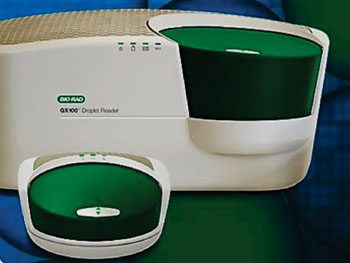Blood Samples Analysis Monitors Colorectal Cancer Chemotherapy Response
By LabMedica International staff writers
Posted on 18 Nov 2015
Circulating cell-free DNA (cfDNA) may be collected from plasma of colorectal cancer patients and represents a less invasive, less costly approach to tracking biomarkers of interest longitudinally and at progression.Posted on 18 Nov 2015
Paired tumor biopsies obtained prior to a given targeted therapy and following progression may inform on dynamic genetic changes which drive resistance; however, these procedures are expensive and associated with risk to colorectal cancer patients.

Image: Droplet digital polymerase chain reaction system (Photo courtesy of Bio-Rad).
Scientists at the MD Anderson Cancer Center (Houston, TX, USA) and their colleagues enrolled patients with refractory B-Raf proto-oncogene, serine/threonine kinase (BRAF)-mutated metastatic colorectal cancer (mCRC) onto a phase I clinical trial of vemurafenib with irinotecan and cetuximab. Restaging scans to assess response to treatment were performed every eight weeks using RECIST 1.1 criteria. Serial plasma samples were collected at treatment initiation, prior to each scheduled dose, and following progression.
Circulating cell-free DNA (cfDNA) was extracted from plasma and analyzed using droplet digital polymerase chain reaction (ddPCR, Bio-Rad; Hercules, CA, USA) to quantify the fraction of mutant BRAFV600E allele relative to BRAF wild-type allele. The cfDNA collected from pretreatment and post-progression plasma samples were analyzed via next-generation sequencing (NGS) using a 68-gene panel (Guardant Health; Redwood City, CA, USA) to identify copy number changes and novel acquired mutations present at progression. Of 19 patients enrolled in the study, serial plasma samples were available for 12.
The median number of plasma samples per patient was 9.5 (range 3 to12). Among the six patients with partial responses radiographically, the median reduction from baseline of BRAFV600E allele was -98% two weeks after treatment initiation. For those with stable disease, the median change was -33%, which was significant when compared to those with partial responses. cfDNA was increasing at the time of progression in all patients (9/9) and preceded progression in 67% (6/9). Novel MEK1C121S, ARAFS490T, and GNASR201C mutations, not identified at baseline, were present at progression. Confirming the digital PCR methodology, NGS identified increased allelic frequency in BRAFV600E, neurofibromatosis type 1 (NF1), and adenomatous polyposis coli (APC) at disease progression.
Van Morris, MD, an assistant professor and lead author of the study said, “BRAF V600E mutations were present in circulating cell-free DNA from all 12 patients in the study for whom serial plasma samples were available, and the direction of change in the ratio of BRAF V600E to BRAF wild-type appeared to correlate with whether or not a tumor responded to treatment. Declines in the ratio preceded detection of a radiographic response and increases, following an initial response, were observed before a radiographic progression.” The study was presented at the International Conference on Molecular Targets and Cancer Therapeutics, held November 5–9, 2015 in Boston (MA, USA).
Related Links:
MD Anderson Cancer Center
Bio-Rad
Guardant Health













